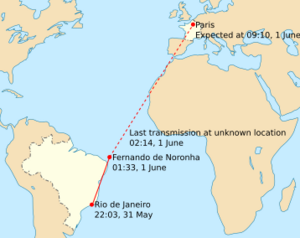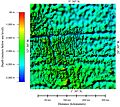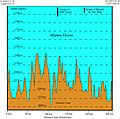Air France Flight 447 facts for kids

F-GZCP, the airplane that crashed, at Charles De Gaulle Airport in 2007.
|
|
| Accident summary | |
|---|---|
| Date | June 1, 2009 |
| Summary | Pitot Tube blockage, pilot error leading to high altitude stall |
| Place | Atlantic Ocean |
| Passengers | 216 |
| Crew | 12 |
| Injuries (non-fatal) | 0 |
| Fatalities | 228 |
| Survivors | 0 (none) |
| Aircraft type | Airbus A330-203 |
| Airline/user | Air France |
| Registration | F-GZCP |
| Flew from | Rio De Janeiro International Airport |
| Flying to | Paris Charles De Gaulle International Airport |
Air France Flight 447 was a regular flight from Rio de Janeiro, Brazil, to Paris, France. The airplane used was an Airbus A330 jet. On June 1, 2009, the A330 crashed into the Atlantic Ocean. This happened about three and a half hours after it took off. All 228 people on board died. This accident is the deadliest plane crash in Air France's history. It is also one of the deadliest plane crashes in the 21st century.
Contents
The Airplane
The airplane was an Airbus A330-203, with the registration F-GZCP. It had two powerful General Electric engines. Airbus delivered the plane new on February 25, 2005. At the time of the accident, it had flown for 18,870 hours. It had also taken off and landed 2,644 times.
People on Board
Because the flight was very long (more than 10 hours), there were three pilots working. This allowed them to take breaks during the flight. The main pilot was Captain Marc Dubois. The other two pilots were Pierre-Cédric Bonin and David Robert. There were also 9 cabin crew members and 216 passengers. In total, 228 people from 33 different countries were on the flight.
The Accident
Air France Flight 447 left Rio de Janeiro International Airport for Paris at 7:29 p.m. Brazilian time. At the start of the flight, Captain Dubois was flying. First Officer Bonin was in the co-pilot's seat. The third pilot, Robert, was resting in a small area behind the cockpit. The plane flew at a height of 35,000 feet (about 10,600 meters). This height is called FL350.
After 1:48 a.m., the plane flew out of radar range. This meant that air traffic controllers could no longer see it on their screens. At 1:55 a.m., the captain woke Robert. He asked Robert to take his place in the cockpit.
At 2:08 a.m., the plane turned left because of turbulence. Just two minutes later, both the autopilot and the auto-thrust systems turned off. These systems usually help fly the plane automatically. Bonin then said, "I have control." He pulled the plane's nose up, causing it to climb quickly. Robert noticed this and told Bonin to lower the nose. Bonin did lower the nose, and the plane stopped climbing as fast. However, it was still going up.
Around 2:11 a.m., the plane reached its highest point. The "angle of attack" was about 16 degrees. The angle of attack is how much the wing is tilted up into the air. The plane then stalled and began to fall. A stall happens when the wings can no longer create enough lift to keep the plane in the air. During the entire fall, the angle of attack stayed very high, above 35 degrees. The plane likely crashed into the ocean at 2:14 a.m. and 28 seconds. This is when all the recordings stopped.
The Search
At 2:20 a.m., the Air Traffic Controller in Dakar, Africa, tried to contact Air France Flight 447. The plane was supposed to be in Dakar's airspace. The controller could not reach the plane. Air France also tried to contact Flight 447 but failed. At this point, people thought the plane had "disappeared." Ships and planes began searching the area where the plane was last known to be. By June 6, it was confirmed that the plane had crashed.
After the search for survivors ended, the search for the plane's recorders began. These are the "black boxes" that record flight data and cockpit sounds. Underwater vehicles were used to listen for signals from the recorders. These signals last for 30 days. However, after 30 days, no sign of the recorders was found. Other searches in 2009 and 2010 also found nothing.
Finally, in 2011, the search for the recorders succeeded. An underwater vehicle found the Flight Data Recorder on April 26. It found the Cockpit Voice Recorder on May 2. These recorders were sent to the BEA (Bureau of Enquiry and Analysis for Civil Aviation Safety) in France. They arrived on May 12 for analysis.
Why the Accident Happened
The investigation found that the plane's "pitot tubes" were blocked by ice crystals. Pitot tubes measure the plane's speed. When they got blocked, the automatic controls, like the autopilot, turned off. This surprised the pilots, even though this problem was known to happen. The pilots probably did not realize that the only issue was incorrect speed readings.
The plane then began to climb. The pilots did not understand what was happening during the climb to 38,000 feet. Even when the plane stalled and a warning sounded, the pilots likely did not understand the stall. So, they did not try to lower the nose and recover the plane. The plane remained stalled until it hit the water.
What Happened After
Right after the crash, Air France quickly started replacing pitot tubes on its planes. By June 11, 2009, all the pitot tubes were changed. The new ones were designed not to freeze up when ice crystals hit them.
The flight number AF 447 was changed to AF 445 after the crash. The route is still flown by Airbus A330-200s.
Documentaries
You can learn more about the crash from these documentaries:
- BBC's one-hour documentary, made before the recorders were found.
- Mayday (also known as Air Crash Investigation), Season 12, Episode 13.
- Fatal Flight 447: Chaos in the Cockpit.
Images for kids
-
Recife, June 8, 2009; Captain Tabosa shows a map with where parts of the Airbus A330-203 were found.
-
Building 153, the main office of the Bureau of Enquiry and Analysis for Civil Aviation Safety (BEA) at Le Bourget Airport, where the flight recorders were studied.
-
The right-hand side-stick control in an Airbus A380 flight deck. This is similar to the one in the A330.
See also
 In Spanish: Vuelo 447 de Air France para niños
In Spanish: Vuelo 447 de Air France para niños











